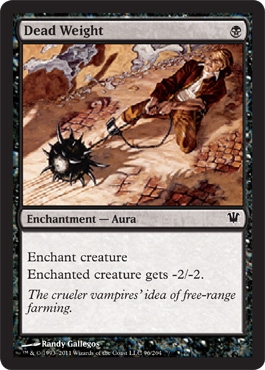

| Encumbrance (PH) | - | - | - | Encumbrance Values of Standard Items (DMG) |
| Encumbrance and Movement | - | - | - | WSG |
Under normal circumstances, any character
needs clothing,
armor, and equipment (including weapons)
to survive in the wilderness.
The advantages of wearing and carrying
equipment far
outweigh the disadvantages. In fact, there
is only one significant
disadvantage: encumbrance.
Practically anything a character wears
or carries contributes to
his degree of encumbrance. Notable exceptions
(as mentioned in
the DMG, page
225) include, but are not necessarily
limited to, the following:
* One set of clothing - normal, light attire,
but not heavy and
bulky cold-weather outerwear.
* Thieves’ picks and tools, or any similar
small and easy-to-carry
items (a small waterskin, a small food
pouch, etc.), when such an
object is the only thing being carried.
* Material components for spells, if such
items are not large or
bulky.
* A helmet
(but not a great helmet) worn by a character who is
also wearing armor.
The encumbrance value of an object is expressed
in gold
pieces, and a standard conversion in the
game system specifies
that a weight of 10 gp is equivalent to
one<1> pound. However, for
purposes of determining an object’s encumbrance
value, this direct
conversion does not always suffice. Although
the weight of
an object is often a major factor, other
considerations are also important.
The volume, or bulkiness, of an object
may be more significant
than its weight; as pointed out on page
101 of the PH, a 20-pound sack of feathers certainly has an
encumbrance
value greater than its actual weight in
gold pieces. Similarly,
a character who is walking while balancing
a 20-foot-long
wooden pole on his shoulder is encumbered
to a much greater
degree than the weight of the pole alone
would indicate.
No set of rules or guidelines can cover
all the objects a character
may want to wear or carry, and for this
reason the DM
will frequently be required to make rulings
on encumbrance
value. As a rule of thumb, any non-bulky
item can be assigned
an encumbrance value equal to, or only
slightly greater
than, its weight in gold pieces; a bulky
object should be given an
encumbrance value of at least two or three
times its weight; and a
very bulky object should have en encumbrance
value of at least
five times its weight.
Table 11: ENCUMBRANCE
LIMITS FOR CHARACTERS
<added directly to Str. table, None
column was added>
<check this : could be one column off>
<as well, an extended version ....
S1 - S25 ... should be done>
........................... Encumbrance Category .........................................................
| Strength | None | Light | Moderate | Heavy | Severe |
| - | - | - | - | - | - |
| 3 | 0-39 | 40-100 | 101-350 | 351-700 | 701-1150 |
| 4 | 0-49 | 50-150 | 151-450 | 451-800 | 801-1250 |
| 5 | ^ | ^ | ^ | ^ | ^ |
| 6 | 0-59 | 60-200 | 201-550 | 551-900 | 901-1350 |
| 7 | ^ | ^ | ^ | ^ | ^ |
| 8 | 0-89 | 90-350 | 351-700 | 701-1050 | 1051-1500 |
| 9 | ^ | ^ | ^ | ^ | ^ |
| 10 | ^ | ^ | ^ | ^ | ^ |
| 11 | ^ | ^ | ^ | ^ | ^ |
| 12 | 0-119 | 120-450 | 451-800 | 801-1150 | 1151-1600 |
| 13 | ^ | ^ | ^ | ^ | ^ |
| 14 | 0-139 | 140-550 | 551-900 | 901-1250 | 1251-1700 |
| 15 | ^ | ^ | ^ | ^ | ^ |
| 16 | 0-159 | 160-700 | 701-1050 | 1051-1400 | 1401-1850 |
| 17 | 0-169 | 170-850 | 851-1200 | 1201-1550 | 1551-2000 |
| 18 | 0-179 | 180-1000 | 1001-1400 | 1401-1700 | 1701-2250 |
| 18/01-50 | 0-189 | 190-1100 | 1101-1450 | 1451-1750 | 1751-2500 |
| 18/51-75 | 0-199 | 200-1200 | 1201-1500 | 1501-1800 | 1801-2750 |
| 18/76-90 | 0-209 | 210-1300 | 1301-1600 | 1601-2000 | 2001-3000 |
| 18/91-99 | 0-221 | 220-1400 | 1401-1700 | 1701-2200 | 2201-3500 |
| 18/00 | 0-249 | 250-1500 | 1501-1900 | 1901-2400 | 2401-4500 |
How to USE the Encumbrance Limits for Characters Table
Calculate the total encumbrance value,
in #, of all
objects worn or carried by the character.
Read across on the line
where the character’s current STR
score appears until reaching
the column that contains the number range
where the encumbrance
value falls. The character’s current encumbrance
status
is described by the heading at the top
of that column.
If the total encumbrance value is less
than the lower number in the “light” column, the character is considered
not encumbered.
An encumbrance value greater than the
higher number in the “Severe” column is effectively impossible; a character
cannot
move, engage in combat, or perform any
other physical activity if
the encumbrance value of his equipment
exceeds this amount --
and he may, at the DM’s discretion, suffer
damage as a result of being overburdened.